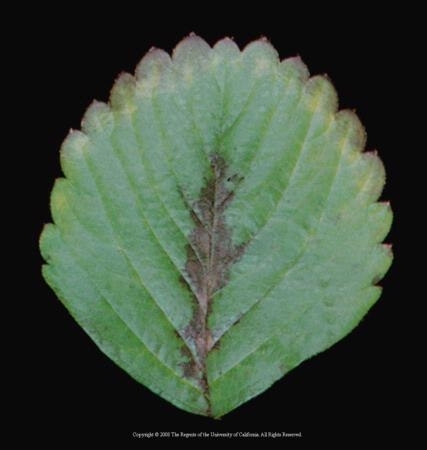We haven't spent much time in this space discussing the plant nutrient potassium (K), because my experience here on the Central Coast in berries is that it rarely shows up as a deficiency. Be that as it may, when UCCE colleague Scott Stoddard (UCCE Farm Advisor in Merced County) recently gave a webinar on this very material together with Compass Minerals, I jumped on the chance to learn more about it.
Potassium in the Plant: Potassium varies in plants depending on age and physiological maturity. A good way to check whether plants are getting enough is to take leaf samples. According to the DRIS work in strawberry I did with UCCE Specialist Tim Hartz and Farm Advisor Mark Gaskell, 1.8 to 2.2% K in the leaf prior to harvest, and 1.3 to 1.8% K during harvest indicates sufficiency in the plants. Note that these levels are for whole leaves, not petioles. Leaf concentrations for caneberries are likely to be pretty close to these, but this has not been empirically investigated in California. Of all the nutrients essential to plant growth, the concentrations of K in the tissue are only surpassed by nitrogen. K is all over in the plant, and some 60% of it is found in the chloroplasts. Since plants, as with nitrogen and phosphorous, will mine their older leaves to move these macronutrients to the younger leaves, K deficiency will first show up in the older leaves. Typical symptoms are white speckling and yellowing and necrosis on leaf margins.
The fruit are also a major sink for this nutrient. For example, in strawberry some 3.7 lbs K2O per acre are removed for every ton of fruit harvested (according to the USDA, raw strawberries contain 153 mg of K per 100 g of fruit), meaning that an average crop yield of strawberries of 6000 ten lb crates is removing 110 lbs K2O per acre.
Potassium in the Soil: Availability in the soil of K to the plant is mediated by many factors including cation exchange capacity (CEC), type of clay, amount of exchangeable K, soil moisture, soil pH, temperatures and to an extent the genetics and developmental stage of the plant. Plant available K exists in the soil in three forms: soil solution K (usually 1 ppm – 10 ppm, which is not nearly enough for plants), exchangeable K (the form of K usually measured by soil tests, mostly found in concentrations of 30-300 ppm, 30 ppm being deficient and 300 ppm being high) and fixed, non-exchangeable K (around 1000 ppm). An equilibrium exists between these three forms, meaning that as the easily available soil solution K is taken up by the plant, it is readily buffered (replaced) by exchangeable K, followed by a more slow buffering and replacement by non-exchangeable K. A laboratory soil test for potassium (ammonium acetate test) measures the soil solution plus exchangeable K. However, it is important to remember that a potassium soil test is a useful but imperfect indicator of K availability to plants. There are situations when supplemental K may be needed even when the soil tests high.
Interference by other Soil Cations: The cations magnesium (Mg), calcium (Ca) and sodium (Na) all can all interfere with plant uptake of K by competing for binding sites in the soil. High alkalinity (high pH), calcareous soils can be cause of a problem with Ca, and Scott shares that soil Mg at 10 times the amount of K (converted to millimole equivalents) can be a source of interference problems as well. For example, research by UC Extensionist Specialist Dr. Tim Hartz and UCCE Farm Advisor Gene Miyao in processing tomatoes has found that if K accounts for less than 2% of the soil CEC, yield and fruit color improve from fertilizer K. In soils deficient in K, or in soils where K is sufficient but Mg is elevated, the magnesium can replace potassium on the exchange complex. Tomatoes have yellow shoulders and melons are soft.
That being said, note that most crops are very resilient to wide ranges of nutrient ratios, and in most areas south of the Sacramento Delta, magnesium has no negative impacts on strawberry production, nor is it commonly known to have negative impacts on strawberry production on the Central Coast.
Attached Images:
